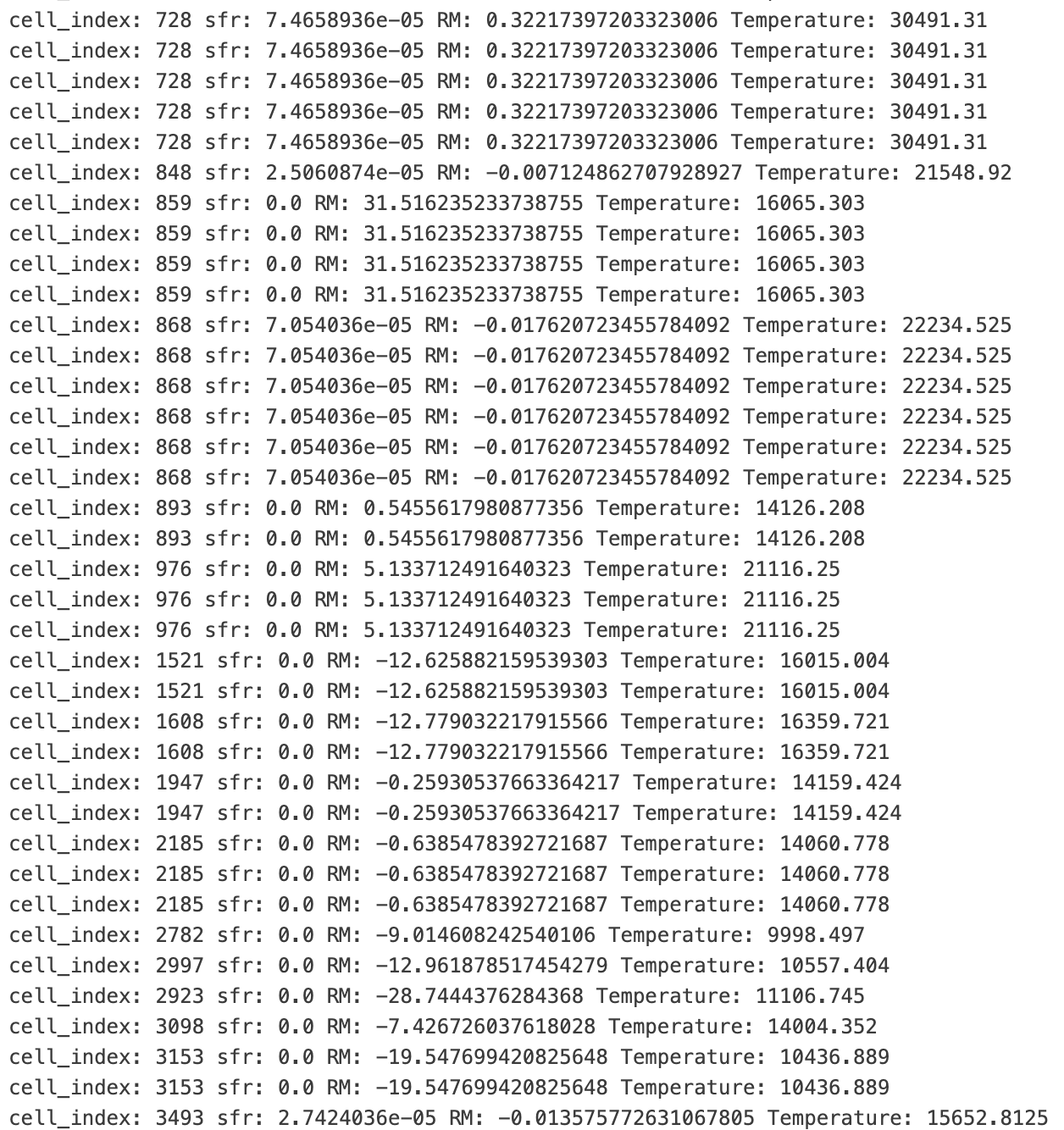Electron number density calculation (for star-forming gas)
Rui Zhou
10 Nov '24
Hi Dylan,
I read some paper regarding calculating Rotation measure (RM) and Dispersion measure (DM), in which calculating n_e is necessary. In their procedure, the star forming cells and non star forming are treated differently: for non-sf cells, they use "ElectronAbundance" times n_H (the number density of hydrogen) to get it. But for sf cells, the ElectronAbundance is modified as x_warm, which is a quantity denotes the mass fraction of warm gas. The typical value for "ElectronAbundance" is around 1, while x_warm is only 10^-4 (this is calculated using x_warm = (t - t_c)/(t_h - t_c), with t_c = 10^3K, t_h = 10^7K, and t, which is usually around 10^4K, is calculated using the provided "InternalEnergy" for the gas cells.) There is a huge difference between sf cells and non-sf cells when calculating n_e.
But here comes my question: the star forming rate seems not continuous, for any cell never goes below 1e-5, except for 0. It seems that a value around 1e-5 might be the resolution of the simulation.
So I should treat those 0s as non-sf cells right? But what if some cells with 0 sfr are actually sf cells? For example, if the sfr is 1e-6 below the threshold. the n_e can be 10000 times different.
I have such question because I saw some cells with similar temperature, density and magnetic field, but one has sfr = 2e-5 and another one 0. The 0 one has an electron density 10000 times greater than the 2e-5 one. Therefore, RM is also 10000 times greater. This lead to my RM calculation dominated by those non-sf cells.
Rui Zhou
10 Nov '24
Here's a more detailed one. The RM for No.2719 cell is 1000 times greater than No.2176 cell
Dylan Nelson
14 Nov '24
I would suggest to read Springel & Hernquist (2003) to get a better idea of why this necessary.
Gas cells with SFR > 0 are on the sub-grid ISM pressurization model, which assumes that the cell is in fact made up of two phases, with very different properties. The hot phase, which is ionized and thus would contribute to DM, has a very small fraction of the mass. This is the calculation you are describing.
You are also correct, that there will be a minimum SFR of gas cells, which represents the simulation resolution in some sense. You can find some discussion of this in Donnari, M. et al. papers.
If a cell has exactly zero SFR, then it is not on the S&H03 ISM model.
Hi Dylan,
I read some paper regarding calculating Rotation measure (RM) and Dispersion measure (DM), in which calculating n_e is necessary. In their procedure, the star forming cells and non star forming are treated differently: for non-sf cells, they use "ElectronAbundance" times n_H (the number density of hydrogen) to get it. But for sf cells, the ElectronAbundance is modified as x_warm, which is a quantity denotes the mass fraction of warm gas. The typical value for "ElectronAbundance" is around 1, while x_warm is only 10^-4 (this is calculated using x_warm = (t - t_c)/(t_h - t_c), with t_c = 10^3K, t_h = 10^7K, and t, which is usually around 10^4K, is calculated using the provided "InternalEnergy" for the gas cells.) There is a huge difference between sf cells and non-sf cells when calculating n_e.
But here comes my question: the star forming rate seems not continuous, for any cell never goes below 1e-5, except for 0. It seems that a value around 1e-5 might be the resolution of the simulation.

So I should treat those 0s as non-sf cells right? But what if some cells with 0 sfr are actually sf cells? For example, if the sfr is 1e-6 below the threshold. the n_e can be 10000 times different.
I have such question because I saw some cells with similar temperature, density and magnetic field, but one has sfr = 2e-5 and another one 0. The 0 one has an electron density 10000 times greater than the 2e-5 one. Therefore, RM is also 10000 times greater. This lead to my RM calculation dominated by those non-sf cells.

Here's a more detailed one. The RM for No.2719 cell is 1000 times greater than No.2176 cell
I would suggest to read Springel & Hernquist (2003) to get a better idea of why this necessary.
Gas cells with SFR > 0 are on the sub-grid ISM pressurization model, which assumes that the cell is in fact made up of two phases, with very different properties. The hot phase, which is ionized and thus would contribute to DM, has a very small fraction of the mass. This is the calculation you are describing.
You are also correct, that there will be a minimum SFR of gas cells, which represents the simulation resolution in some sense. You can find some discussion of this in Donnari, M. et al. papers.
If a cell has exactly zero SFR, then it is not on the S&H03 ISM model.